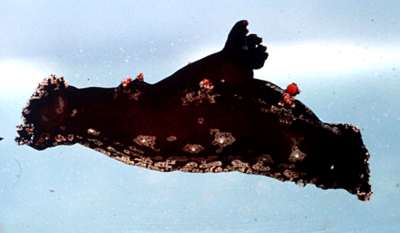

'Euplocamus' maculatus
Bergh, 1898
Order: NUDIBRANCHIA
Suborder: DORIDINA
Superfamily: ANADORIDOIDEA
Family: Polyceridae
Subfamily: Triophinae
DISTRIBUTION
Known only from San Felix Island and Juan Fernández Archipelago, Chile.
PHOTO
Red specimen: Bahía del Padre, Robinson Crusoe Island; Robinson Crusoe Island, Juan Fernández Archipelago (around 33°S 80°W), March 2005. found intertidally, between volcanic boulders on Ulva rigida ). Photo: F. Bravo. Dark specimen: San Felix Island, Chile. (26°17'S, 80°05'W). 1997. Photo: R. Bieler. (up to approx. 6 cm long).
These large triophid nudibranchs (up to approx. 6 cm) were found on the offshore islands of Chile. The only triophid species previously recorded from this area was Euplocamus maculatus Bergh, 1898 (see Schrödl, 2003); the genus name Euplocamus was later replaced by Kaloplocamus (see Bergh, 1892). The original description of K. maculatus (Bergh, 1898) was based on a single, preserved specimen; its small size (4 mm) indicating it was juvenile. Odhner (1921) reported on an additional preserved specimen (10 mm) and gave a very brief external description. These much larger and certainly adult specimens agree in external features, i.e. in having a frontal veil with several to many short, ramified papillae, a smooth or just slightly "granulated" notum, 3-4 pairs of ramified processes at the notal edges, 3 to 5 gills, and a keeled tail.
Bergh (1898) described his preserved specimen to be white with irregular rows of brownish-black markings along the central notum, the notal margins, and on the head veil; a few markings also were on the body sides and on the foot sole. One of our living specimens was entirely red with some white markings, while others are reddish brown with white mottles or are almost entirely dark brown. We think that our specimens are adult Kaloplocamus maculatus (Bergh, 1898) showing considerable colour variation that is documented here for the first time. It grows at least to 6 cm long alive.
If so, some taxonomic reconsideration is necessary: unlike species currently placed into the genus Kaloplocamus, our specimens show a well-developed head veil with numerous, short, ramified papillae. Furthermore, at least the posterior pair of notal edge processes shows an apical, spherical organ that is known to produce bioluminescent light in some species; this terminal sphere is regarded characteristic for Plocamopherus as is the possession of a laterally flattened tail that may be used for active swimming. Transferring K. maculatus to the genus Plocamopherus would, however, create a homonym to the externally distinct P. maculatus (Pease, 1860), known only from Hawaii. A detailed anatomical redescription is needed to clarify whether or not K. maculatus is specifically distinct from externally similar congeners such as the eastern Australian Plocamopherus imperialis Angas, 1864.
- BERGH, L.S.R. 1898. Die Opisthobranchier der Sammlung Plate. Zoologische Jahrbücher Supplement 4: 481-582.
- ODHNER, N.H. 1921. Mollusca from Juan Fernández and Easter Island. In: Natural History of Juan Fernández and Easter Island, vol. 3 (C. Skottsberg, ed.), pp. 219-254, pls. 8-9.
- SCHRÖDL, M. 2003. Sea Slugs of Southern South America. ConchBooks, Hackenheim. 165 pp.
Bravo, F., Duarte, G., Bieler, R. & Schrödl, M, 2005 (September 2) 'Euplocamus' maculatus Bergh, 1898 . [In] Sea Slug Forum. Australian Museum, Sydney. Available from http://www.seaslugforum.net/factsheet/euplmacu
Related messages
-
Plocamopherus from Chile
From: F. Bravo, G. Duarte, R. Bieler & M. Schrödl, September 2, 2005
